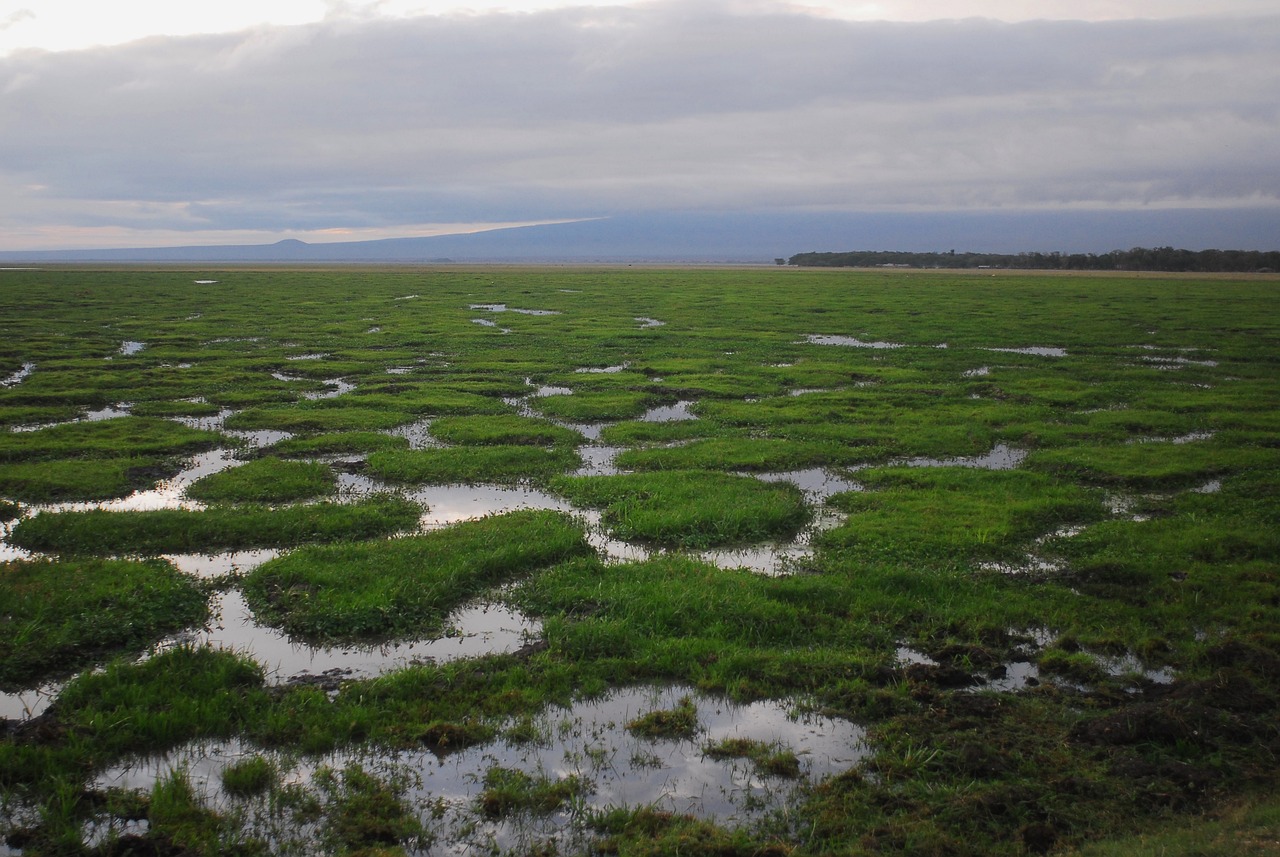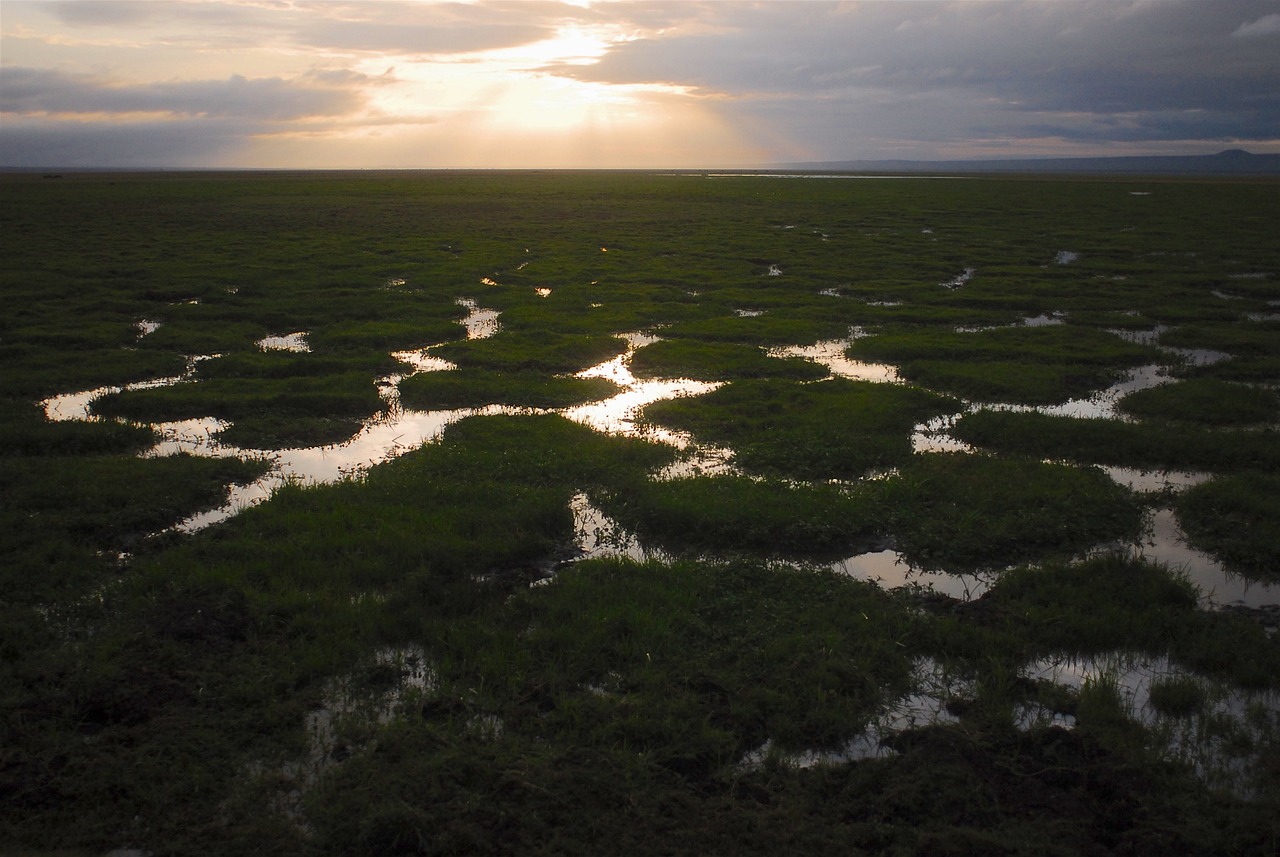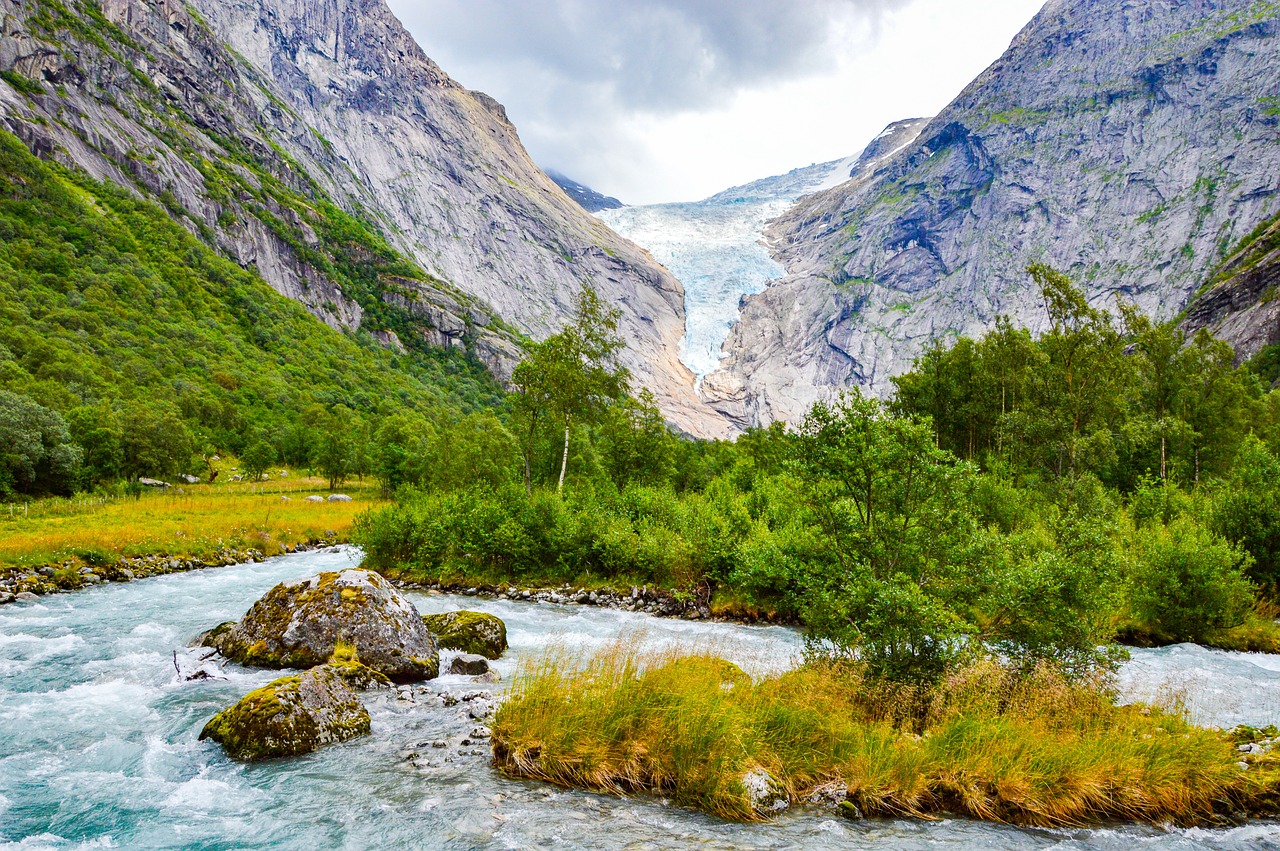Climate Change: Are Clouds Amplifying Global Warming?
Climate change is one of the most pressing issues facing our planet today, and understanding its nuances is crucial. Among the many factors that contribute to this phenomenon, clouds play a surprisingly complex role. You might think of clouds as mere fluff in the sky, but they are much more than that. They are dynamic players in the Earth's climate system, influencing temperatures and weather patterns in ways that can either exacerbate or mitigate global warming. Have you ever wondered how something so seemingly benign could have such a profound impact on our environment? Let’s dive into the intricate relationship between clouds and climate change, exploring how their formation and behavior might amplify the effects of global warming.
Clouds are not just pretty formations; they are vital components of our climate system. They regulate Earth's temperature by reflecting sunlight back into space and trapping heat in the atmosphere. This dual role makes them essential for predicting future climate scenarios. Without clouds, our planet would be a much hotter place, but too many clouds can lead to a different set of problems. Understanding how clouds interact with solar radiation and greenhouse gases is key to unraveling the complexities of climate change. For instance, did you know that clouds can reflect about 20% to 30% of incoming solar radiation? This is a significant number that highlights their cooling effect, yet the same clouds can also trap heat, leading to warmer temperatures. It’s a delicate balance that scientists are still trying to fully comprehend.
Not all clouds are created equal. They vary in altitude, composition, and their effects on climate. Broadly, clouds can be categorized into three types: low, middle, and high clouds, each with unique characteristics and impacts. Understanding these differences is crucial for grasping their role in the greenhouse effect. For example:
- Low clouds (like stratus and cumulus) tend to have a warming effect, as they trap heat close to the Earth's surface.
- Middle clouds (such as altostratus) can have both warming and cooling effects depending on their thickness and coverage.
- High clouds (including cirrus) are typically thin and can allow sunlight to warm the Earth while also trapping heat.
This classification helps us understand how each type of cloud contributes to climate change. For instance, while stratus clouds may cool the Earth, cumulus clouds can trap heat, creating a paradox that complicates climate modeling.
Cumulus clouds, those fluffy white clouds we often associate with beautiful weather, have a more complex relationship with global warming than you might expect. While they can provide shade and cool the ground below, they also have the ability to trap heat in the atmosphere. This duality presents a fascinating paradox: how can clouds that seem so innocent contribute to rising temperatures? The answer lies in their formation and behavior. When cumulus clouds form, they can create feedback loops that enhance warming. For instance, as the atmosphere warms, more cumulus clouds can form, which in turn traps more heat, leading to even higher temperatures. It’s a cycle that can escalate quickly, making it essential for scientists to monitor these clouds closely.
The presence of cumulus clouds can significantly alter local weather patterns. Have you ever noticed how a sunny day can suddenly turn cloudy, bringing rain? This is no coincidence. Cumulus clouds can influence rainfall and temperature, impacting everything from agriculture to water supply. Their localized effects can lead to dramatic shifts in weather, which become increasingly important as climate change progresses. For instance, areas that rely on consistent rainfall may find themselves facing droughts or floods due to changing cloud patterns. Understanding these local impacts is crucial for developing adaptive strategies to cope with climate change.
As mentioned earlier, cumulus clouds can create feedback loops that amplify warming. These feedbacks are critical for climate models and predictions. When more heat is trapped by these clouds, it can lead to increased evaporation and more moisture in the atmosphere, which can, in turn, lead to more cloud formation. This creates a cycle that can be difficult to break. Scientists are working diligently to incorporate these feedback mechanisms into climate models to improve predictions about future warming scenarios. The more we understand these processes, the better equipped we will be to tackle the challenges of climate change.
On the flip side, we have stratus clouds, which typically exert a cooling influence on the Earth’s surface. These clouds are often thick and gray, covering the sky like a blanket. Their reflective properties help mitigate some of the warming effects caused by other types of clouds. In fact, stratus clouds can reflect a significant amount of sunlight, which helps to cool the atmosphere. This cooling effect is crucial, especially in regions where temperatures are rising rapidly. By reflecting sunlight, stratus clouds act as a natural thermostat, providing a counterbalance in the intricate dynamics of climate regulation.
Understanding cloud feedback mechanisms is essential for grasping climate sensitivity. These mechanisms describe how cloud formation and dissipation processes can either amplify or mitigate climate change. For instance, when temperatures rise, more clouds may form, which can further trap heat and create a positive feedback loop. Conversely, certain clouds can help stabilize temperatures by reflecting sunlight, creating negative feedback loops. The balance between these opposing forces is delicate and has significant implications for future climate scenarios.
Positive feedback loops occur when cloud behavior enhances warming. For example, as the planet warms, the atmosphere can hold more moisture, leading to more cloud formation. This increase in clouds can trap even more heat, exacerbating the warming trend. The implications of these feedback loops are profound, as they can lead to accelerated climate change, making it essential for researchers to understand and model these interactions accurately.
On the other hand, negative feedback loops can stabilize temperatures by reflecting sunlight. These clouds work to counteract warming effects, showcasing their dual role in climate regulation. For instance, if stratus clouds become more prevalent due to warming, their reflective properties could help cool the Earth. This balance is critical for maintaining a stable climate, and understanding these dynamics is vital for developing effective climate policies.
Ongoing research is vital for unraveling the complexities of cloud interactions with climate change. Scientists are continually exploring new technologies and methodologies to improve climate models and predictions. Key areas for future investigation include:
- Understanding cloud microphysics and their interactions with aerosols.
- Investigating the role of clouds in extreme weather events.
- Improving satellite observations to monitor cloud behavior.
By focusing on these areas, researchers aim to enhance our understanding of how clouds influence climate change and improve our ability to predict future scenarios. The stakes are high, and the time to act is now.
Q: How do clouds contribute to climate change?
A: Clouds can both trap heat and reflect sunlight, creating complex interactions that can either amplify or mitigate global warming.
Q: What types of clouds have the most significant impact on climate?
A: Cumulus clouds can trap heat, while stratus clouds typically reflect sunlight, providing a cooling effect.
Q: Why is cloud feedback important for climate models?
A: Cloud feedback mechanisms are critical for understanding climate sensitivity and predicting future climate scenarios accurately.
Q: What is the future of cloud research in relation to climate change?
A: Future research will focus on improving our understanding of cloud interactions, their role in extreme weather, and enhancing satellite observations.

The Role of Clouds in Climate Regulation
Clouds are not just fluffy white formations drifting across the sky; they are powerful players in the game of climate regulation. Think of them as nature's thermostat, influencing the Earth's temperature and precipitation patterns in profound ways. Their presence can either warm the planet or cool it down, depending on various factors. Understanding the intricate dynamics of clouds is essential if we want to predict how climate change will unfold in the coming years.
One of the primary ways clouds regulate climate is through their reflective properties. When sunlight hits the Earth's surface, some of it is absorbed, warming the ground. However, clouds can reflect a significant portion of this sunlight back into space. This effect is particularly pronounced with low, thick clouds, which can create a cooling effect on the planet. Conversely, high, thin clouds tend to allow sunlight to pass through while trapping heat, contributing to the greenhouse effect. This duality makes clouds a fascinating and complex component of climate science.
Moreover, clouds also influence precipitation patterns. They are responsible for rain, snow, and other forms of precipitation, which are vital for replenishing our water supply and maintaining ecosystems. The type of cloud present can determine not just whether it rains, but how much and how often. For instance, cumulonimbus clouds can unleash torrential downpours, while stratus clouds might lead to light drizzles over extended periods. This variability plays a crucial role in agriculture, water management, and even disaster preparedness.
In essence, clouds act as both cooling and warming agents, depending on their type and behavior. Here’s a quick breakdown of how different cloud types contribute to climate regulation:
| Cloud Type | Effect on Climate |
|---|---|
| Cumulus | Can trap heat, potentially leading to warming. |
| Stratus | Reflects sunlight, contributing to cooling. |
| Cumulonimbus | Causes heavy precipitation, affecting local climates. |
| Cirrus | Traps heat, contributing to the greenhouse effect. |
Understanding these roles is crucial for climate scientists as they develop models to predict future climate scenarios. As we continue to grapple with the effects of climate change, recognizing how clouds interact with other elements of the climate system will be key. Will they amplify warming? Or will they help mitigate it? The answer lies in ongoing research and observation.
- How do clouds affect global warming? Clouds can either trap heat and contribute to warming or reflect sunlight and cool the Earth, depending on their type and characteristics.
- What types of clouds are most influential in climate regulation? Cumulus, stratus, and cumulonimbus clouds each have unique effects on temperature and precipitation, playing crucial roles in climate dynamics.
- Why is understanding clouds important for climate predictions? Clouds significantly influence temperature and precipitation patterns, making them essential for accurate climate models and future predictions.

The atmosphere is a complex tapestry woven with various types of clouds, each playing a unique role in shaping our climate. Understanding these distinctions is not just an academic exercise; it’s crucial for grasping how different cloud types contribute to the greenhouse effect and, consequently, global warming. Clouds can be broadly categorized into three main types based on their altitude: low, middle, and high clouds. Each category has its own characteristics and impacts on climate.
Low clouds, such as stratus and cumulus, typically form below 2,000 meters. Stratus clouds are thick and gray, often bringing overcast skies and light rain. They reflect sunlight back into space, which can have a cooling effect on the Earth’s surface. On the other hand, cumulus clouds, which are puffy and white, are often seen on sunny days. However, they can also trap heat, creating a paradox where they contribute to warming despite their fair-weather associations.
Moving up the altitude scale, we encounter middle clouds, like altostratus and altocumulus. These clouds usually form between 2,000 and 7,000 meters and can signal a change in weather patterns. They tend to have a more muted effect on temperature compared to low clouds but can still contribute to the overall dynamics of climate change.
Finally, we have high clouds, such as cirrus, cirrostratus, and cirrocumulus, which float above 7,000 meters. These wispy clouds are often composed of ice crystals and can trap heat in the atmosphere, contributing to the greenhouse effect. Their thin structure allows some sunlight to penetrate, but they also prevent heat from escaping back into space, thus amplifying warming.
To summarize the impact of different cloud types, let’s take a look at the following table:
| Cloud Type | Altitude | Impact on Climate |
|---|---|---|
| Low Clouds (Stratus, Cumulus) | Below 2,000 m | Cooling effect (Stratus); Warming effect (Cumulus) |
| Middle Clouds (Altostratus, Altocumulus) | 2,000 - 7,000 m | Moderate impact on temperature; can signal weather changes |
| High Clouds (Cirrus, Cirrostratus, Cirrocumulus) | Above 7,000 m | Warming effect due to heat trapping |
Understanding these cloud dynamics is like piecing together a puzzle; each cloud type adds a unique piece that influences the bigger picture of our climate system. By recognizing how each type interacts with sunlight and heat, we can better predict future climate scenarios and understand the potential impacts of climate change on our planet.

Cumulus clouds, those fluffy, white formations that often resemble cotton balls floating across a blue sky, are more than just a picturesque element of our weather. They have a complex relationship with global warming that can be quite surprising. While we often associate these clouds with fair weather, their role in the climate system is anything but straightforward. In fact, they can act as a double-edged sword when it comes to temperature regulation.
On one hand, cumulus clouds can help to cool the Earth's surface by reflecting sunlight back into space. This is particularly true during the day when the sun's rays are at their strongest. However, the situation changes at night. When the sun sets, these clouds can trap heat radiating from the Earth, creating a warming effect that can exacerbate global temperatures. This paradox is what makes cumulus clouds a fascinating subject of study in climate science.
To understand their influence better, let's break down how cumulus clouds interact with the atmosphere:
- Heat Trapping: Cumulus clouds can act like a blanket, holding in heat during the night. This phenomenon can lead to higher nighttime temperatures, which can affect local ecosystems and weather patterns.
- Humidity Regulation: These clouds are formed from rising warm air, which carries moisture. As they develop, they can impact local humidity levels, influencing precipitation patterns.
- Feedback Mechanisms: The presence of cumulus clouds can initiate feedback loops that either amplify or mitigate warming. For example, if warming leads to more cumulus cloud formation, this could further enhance warming through heat retention.
Research has shown that the interplay between cumulus clouds and climate change is intricate. Climate models often struggle to accurately predict how these clouds will behave in a warming world. Some studies suggest that as global temperatures rise, the amount of cumulus cloud cover could increase, leading to even greater heat retention. This creates a feedback loop that could accelerate climate change, making it crucial for scientists to understand these dynamics.
In summary, cumulus clouds are not just a sign of pleasant weather; they are active participants in the climate system. Their ability to trap heat at night and influence local weather patterns underscores the need for further research. As we continue to grapple with the realities of climate change, understanding the role of cumulus clouds will be essential in predicting future climate scenarios and developing effective mitigation strategies.
- What are cumulus clouds? Cumulus clouds are puffy, white clouds that typically indicate fair weather. They form when warm air rises and cools, causing moisture to condense.
- How do cumulus clouds affect global warming? Cumulus clouds can trap heat at night, leading to increased temperatures, while also reflecting sunlight during the day, which can cool the surface.
- Why are cumulus clouds important in climate science? Their dual role in warming and cooling makes them critical for understanding climate feedback mechanisms and predicting future climate scenarios.

The presence of cumulus clouds can significantly alter local weather patterns, creating a ripple effect that influences everything from daily temperatures to precipitation levels. Imagine walking outside on a sunny day, only to see fluffy cumulus clouds forming in the distance. Those clouds are not just beautiful; they are actively participating in a complex dance with the atmosphere. As these clouds develop, they can trap heat from the Earth's surface, leading to a phenomenon known as the urban heat island effect, especially in cities where concrete absorbs and retains heat.
One of the most fascinating aspects of cumulus clouds is their ability to enhance or suppress rainfall. When these clouds grow taller and begin to develop into cumulonimbus clouds, they can lead to thunderstorms and heavy downpours. Conversely, in some situations, they can create a cap that prevents moisture from rising, resulting in dry spells. This duality plays a critical role in shaping local climates. For instance, regions that experience frequent cumulus cloud formation may have more variable weather, with sudden shifts from sunny to stormy conditions.
To illustrate these impacts, consider the following table that summarizes the effects of cumulus clouds on local weather:
| Effect | Description |
|---|---|
| Temperature Regulation | Cumulus clouds can trap heat, increasing local temperatures during the day. |
| Precipitation Variability | They can lead to sudden rain showers or prolonged dry spells, depending on their development. |
| Storm Development | When cumulus clouds grow into cumulonimbus, they can trigger thunderstorms. |
Furthermore, the interaction between cumulus clouds and local topography can enhance these effects. For example, in mountainous regions, rising air can lead to more intense cloud formation, which can result in localized rainfall patterns that are vastly different from surrounding areas. This phenomenon is often referred to as orographic lift, where moist air is forced to rise over a mountain range, cooling and condensing to form clouds and precipitation.
Understanding these localized impacts is essential, as they can influence agricultural practices, water resource management, and even urban planning. Farmers, for instance, need to know when to plant or harvest their crops based on expected rainfall patterns influenced by cloud behavior. Similarly, city planners must consider how increased cloud cover could affect heat levels in urban areas, which can lead to higher energy consumption for cooling.
In conclusion, cumulus clouds are not merely passive participants in the atmosphere; they are dynamic entities that can significantly impact local weather patterns. Their ability to influence temperature and precipitation makes them a crucial factor in understanding climate change and its effects on our daily lives.
- How do cumulus clouds affect local temperatures? Cumulus clouds can trap heat, leading to warmer temperatures during the day, especially in urban areas.
- Can cumulus clouds lead to severe weather? Yes, when cumulus clouds develop into cumulonimbus clouds, they can cause thunderstorms and heavy rainfall.
- What is orographic lift? Orographic lift occurs when moist air is forced to rise over mountains, leading to increased cloud formation and precipitation in those areas.

Cumulus clouds, those fluffy, cotton-like formations that often dot the sky on sunny days, are more than just a picturesque element of our atmosphere. They play a significant role in the complex web of climate feedbacks that can either amplify or mitigate global warming. When we talk about feedback loops in climate science, we're referring to processes that can either enhance or dampen the effects of climate change. Cumulus clouds are a prime example of this duality, presenting a fascinating paradox.
On one hand, cumulus clouds can trap heat in the atmosphere. During the day, they can absorb sunlight and re-radiate it back toward the Earth’s surface, contributing to a warming effect. This is particularly evident in regions where these clouds are prevalent. As they form and dissipate, they can create a cycle that leads to increased temperatures, which in turn can promote the formation of more cumulus clouds. This creates a positive feedback loop: warmer temperatures lead to more clouds, which then trap even more heat. The implications of this are significant, especially as we consider the broader impacts of climate change.
On the flip side, cumulus clouds also have the potential to influence local weather patterns in ways that can mitigate warming. For instance, during the evening, these clouds can help maintain warmth by acting like a blanket, preventing heat from escaping into the atmosphere. However, when they form in larger clusters, they can lead to increased rainfall and cooler temperatures, particularly in localized areas. This cooling effect can provide a counterbalance to the overall warming trend, showcasing the complex interactions between cloud formation and climate dynamics.
Understanding these feedback mechanisms is crucial for climate scientists as they work to refine climate models and predictions. By analyzing how cumulus clouds interact with temperature changes, researchers can gain insights into future climate scenarios. For example, if cumulus clouds continue to form more frequently due to rising temperatures, we may see an acceleration in warming, complicating our efforts to combat climate change. Conversely, if they can effectively reflect sunlight and promote cooling, they could play a role in stabilizing our climate system.
In summary, cumulus clouds embody the intricate dance of climate feedbacks. Their ability to both trap heat and influence local weather patterns makes them a vital area of study in understanding how our planet's climate is changing. As we continue to explore the impacts of these clouds, we can better prepare for the future and develop strategies to mitigate the effects of global warming.
- What are cumulus clouds? Cumulus clouds are fluffy, white clouds often associated with fair weather, characterized by their cotton-like appearance.
- How do cumulus clouds affect climate? They can trap heat, contributing to warming, but also have cooling effects depending on their formation and behavior.
- What is a climate feedback loop? A climate feedback loop is a process where an initial change in the climate leads to effects that either amplify or reduce that change.
- Why are cumulus clouds important in climate science? Their complex interactions with temperature and weather patterns make them critical for understanding climate dynamics and improving climate models.

Stratus clouds, often seen as a blanket of gray covering the sky, play a fascinating role in the Earth's climate system. Unlike their more dynamic cousins, cumulus clouds, stratus clouds tend to form in stable atmospheric conditions and can linger for extended periods. This persistence gives them a unique ability to influence the temperature of the Earth's surface. You might wonder, how do these seemingly mundane clouds contribute to cooling our planet? Well, let’s dive into the science behind it.
One of the primary mechanisms through which stratus clouds exert their cooling effects is their reflective properties. These clouds are typically composed of tiny water droplets that scatter sunlight, preventing a significant amount of solar radiation from reaching the ground. This phenomenon is akin to having a natural sunshade; while the sun's rays are still present, the intensity of the heat is significantly reduced. Studies suggest that when stratus clouds cover the sky, they can reflect up to 50-70% of incoming solar radiation.
| Cloud Type | Reflectivity (% of Solar Radiation) | Typical Weather Conditions |
|---|---|---|
| Stratus | 50-70% | Overcast, drizzly |
| Cumulus | 20-30% | Fair weather, scattered |
| Cumulonimbus | 30-50% | Thunderstorms, heavy precipitation |
Moreover, stratus clouds can also help to stabilize local temperatures. By acting as an insulating layer, they limit the amount of heat that escapes from the Earth’s surface during the night. This means that while daytime temperatures might be moderated due to their reflective nature, nighttime temperatures can remain relatively warm, creating a more stable temperature range. Think of stratus clouds as a cozy blanket that keeps you warm during chilly nights.
However, the cooling effects of stratus clouds are not uniform across the globe. Their impact varies significantly depending on geographical location and seasonal changes. For instance, in coastal areas, stratus clouds are more prevalent during certain times of the year, contributing to cooler temperatures that can influence local ecosystems. In urban settings, the urban heat island effect can sometimes overshadow the cooling influence of stratus clouds, leading to warmer temperatures despite their presence.
It’s also important to consider the broader implications of stratus clouds in the context of climate change. As global temperatures rise, the behavior of these clouds could change, potentially altering their cooling effects. If stratus clouds become more frequent or persistent, they could help mitigate some warming. Conversely, if they dissipate due to changing climate patterns, we might face increased warming. This duality makes understanding stratus clouds essential for climate scientists attempting to predict future climate scenarios.
In summary, stratus clouds may appear to be simple and unassuming, but their cooling effects are significant in the grand scheme of climate regulation. By reflecting sunlight and stabilizing temperatures, they provide a counterbalance to some of the warming effects caused by greenhouse gases. As we continue to study these clouds, we may uncover even more about their role in our changing climate.
- What are stratus clouds? Stratus clouds are low, gray clouds that usually cover the entire sky like a blanket, often bringing overcast conditions and light drizzle.
- How do stratus clouds affect temperature? They reflect sunlight, which helps to cool the Earth’s surface during the day, and they can also trap heat at night, stabilizing temperatures.
- Are stratus clouds common? Yes, stratus clouds are quite common, especially in coastal areas and during specific seasons.
- Can stratus clouds contribute to climate change? Yes, their behavior and prevalence can influence local temperatures and climate patterns, making them an important factor in climate studies.

The dynamics of cloud feedback mechanisms are pivotal in understanding how our planet's climate is shifting in response to global warming. Essentially, these mechanisms describe how clouds can either amplify or mitigate the effects of climate change. As we delve into this fascinating subject, it's important to recognize that clouds are not just passive players in the climate system; they actively interact with various elements, creating a complex web of influences that can either exacerbate or alleviate warming trends.
To grasp the significance of cloud feedback, we need to consider two primary types of feedback loops: positive and negative. Positive feedback loops occur when cloud formation leads to increased warming. For instance, as temperatures rise, certain types of clouds, particularly cumulus clouds, may form in greater abundance, trapping more heat in the atmosphere. This phenomenon can create a cycle where rising temperatures lead to more cloud cover, which in turn causes even higher temperatures. It's like adding fuel to a fire; the more you add, the bigger it gets!
On the other hand, negative feedback loops can act as a cooling mechanism. Stratus clouds, which are typically low and flat, have a reflective quality that can send sunlight back into space. This can help to reduce surface temperatures, providing a counterbalance to the warming effects of greenhouse gases. Imagine wearing a light-colored shirt on a hot day; it reflects sunlight and keeps you cooler, just like these clouds do for our planet.
Understanding these feedback mechanisms is crucial for climate scientists as they develop models to predict future climate scenarios. The interplay between cloud types and climate change is intricate and multifaceted. For instance, researchers are investigating how changes in cloud cover can affect regional climates differently. Some areas might experience intensified warming due to increased cumulus cloud formation, while others could benefit from the cooling effects of stratus clouds.
In summary, cloud feedback mechanisms are a double-edged sword in the realm of climate change. They can either enhance the warming effects of greenhouse gases through positive feedback loops or help to stabilize temperatures via negative feedback loops. As we continue to study these phenomena, it becomes increasingly clear that clouds are not merely a backdrop to weather events; they are active participants in the global climate system, influencing everything from local weather patterns to global temperature trends.
- What are cloud feedback mechanisms?
Cloud feedback mechanisms refer to the ways in which clouds interact with climate change, either amplifying or mitigating its effects. - How do positive feedback loops work?
Positive feedback loops occur when cloud formation leads to increased warming, creating a cycle of rising temperatures and more cloud cover. - What is the role of stratus clouds in climate regulation?
Stratus clouds can reflect sunlight back into space, providing a cooling effect that can counteract warming trends. - Why are cloud feedback mechanisms important for climate models?
Understanding cloud feedback mechanisms is essential for accurately predicting future climate scenarios and developing effective climate policies.

Positive feedback loops are fascinating phenomena that occur when certain processes amplify changes in the climate system. In the context of clouds, these loops can significantly enhance warming, leading to a cascade of effects that may ultimately alter the planet's climate. Imagine clouds as players in a game where they can either help or hinder the outcome; unfortunately, in many scenarios, they tend to play for the warming team.
One key way that clouds contribute to positive feedback loops is through their ability to trap heat. When the Earth warms due to greenhouse gas emissions, it leads to increased evaporation of water from oceans and other bodies of water. This process generates more water vapor in the atmosphere, which is itself a potent greenhouse gas. As the concentration of water vapor rises, it enhances the greenhouse effect, trapping even more heat and causing temperatures to rise further. This cycle continues as warmer temperatures lead to more evaporation and, consequently, more clouds.
Furthermore, certain types of clouds, particularly cumulus clouds, can exacerbate this warming. These clouds can form in response to increased surface temperatures, and while they may provide some cooling during the day by reflecting sunlight, they also trap heat at night. This dual role creates a complicated relationship where the overall effect can lead to increased warming. The net result is that as the planet warms, the behavior of these clouds can further intensify that warming, creating a feedback loop that is challenging to break.
To illustrate this process, consider the following table that summarizes the steps involved in positive feedback loops related to cloud formation:
| Step | Process | Effect |
|---|---|---|
| 1 | Increased greenhouse gas emissions | Global warming |
| 2 | Higher evaporation rates | More water vapor in the atmosphere |
| 3 | Cloud formation | Increased heat trapping |
| 4 | Further warming | More evaporation and cloud formation |
This cycle can have profound implications for climate models and predictions. As scientists work to understand these feedback mechanisms, they must account for the unpredictable nature of cloud behavior. The complexities involved make it clear that accurately predicting future climate scenarios is no easy feat.
In conclusion, positive feedback loops involving clouds are crucial to understanding how climate change progresses. They illustrate the interconnectedness of various climate systems and highlight the urgent need for comprehensive climate research. Without addressing these feedback mechanisms, our efforts to combat global warming may be hampered by the very clouds that we often overlook.
- What are positive feedback loops? Positive feedback loops are processes that amplify changes in a system, often leading to accelerated effects, such as increased warming in the context of climate change.
- How do clouds contribute to global warming? Clouds can trap heat in the atmosphere, leading to an increase in global temperatures, particularly through the formation of water vapor.
- Are all clouds harmful to the climate? Not all clouds have the same effect; while some contribute to warming, others, like stratus clouds, can have cooling effects.

Negative feedback loops in the context of climate change are like a natural thermostat for our planet. When the Earth warms up, certain cloud behaviors can kick in to help cool things down. This is crucial because it illustrates how clouds can play a dual role in climate dynamics, acting as both amplifiers and mitigators of global warming. Imagine a cozy blanket that can be adjusted—too hot? You can throw it off a bit. This is how negative feedback loops work in the atmosphere.
One of the primary ways clouds provide this cooling effect is through their reflective properties. Stratus clouds, for example, are known to reflect sunlight back into space, thereby reducing the amount of solar energy that reaches the Earth's surface. This can lead to a cooling effect, especially during the warmer months. When these clouds are present, they can lower temperatures significantly, acting as a shield against excessive heat. Think of them as nature's sunglasses, protecting us from the harsh rays of the sun.
Moreover, the formation of low-altitude clouds can increase the albedo effect, which is a measure of how much sunlight is reflected by a surface. When the albedo increases, less solar energy is absorbed, leading to cooler temperatures. This is particularly important in regions that are already experiencing warming trends. To illustrate this point, consider the following table that summarizes the relationship between cloud types, their reflective properties, and their cooling effects:
| Cloud Type | Altitude | Reflective Properties | Cooling Effect |
|---|---|---|---|
| Stratus | Low | High | Significant |
| Cumulus | Medium | Moderate | Variable |
| Cirrus | High | Low | Minimal |
In addition to their reflective properties, negative feedback loops are also influenced by the processes of cloud formation and dissipation. When temperatures rise, the increased evaporation can lead to more cloud formation. However, if the clouds are thick enough, they can block sunlight and cool the surface below. This is a fascinating interplay, as it shows how interconnected our climate systems are. It's like a dance where one partner leads, but the other can still influence the outcome. The balance between warming and cooling is delicate, and understanding these mechanisms is crucial for climate scientists.
However, it’s important to note that while negative feedback loops can help stabilize temperatures, they are not a cure-all. The complexity of the climate system means that various factors can influence these feedbacks, and their effectiveness can vary depending on regional conditions and other atmospheric elements. Therefore, while clouds may offer some relief from warming, they are part of a larger, intricate web of interactions that define our climate.
- What are negative feedback loops? Negative feedback loops are processes that counteract changes in the climate, helping to stabilize temperatures.
- How do clouds contribute to cooling? Clouds can reflect sunlight back into space, which reduces the amount of solar energy absorbed by the Earth.
- Are all clouds beneficial for cooling? Not all clouds have the same effect; for example, stratus clouds are more effective at reflecting sunlight than cirrus clouds.
- Can negative feedback loops prevent global warming? While they can help mitigate some warming effects, they are not sufficient to completely counteract global warming.

As we stand on the brink of a climate crisis, understanding the intricate dance between clouds and climate change has never been more crucial. Future research directions must focus on unraveling the complexities of cloud interactions with our atmosphere. Scientists are keen to dive deeper into several key areas, which could significantly enhance our climate models and predictions.
One of the primary areas of interest is the role of cloud microphysics. This involves studying the tiny particles that make up clouds and how they influence cloud formation and behavior. By understanding these microphysical processes, researchers can better predict how different types of clouds will respond to a warming climate. For instance, will cumulus clouds become more prevalent, or will stratus clouds dominate? The answers to these questions could reshape our understanding of future weather patterns.
Another essential focus is on cloud feedback mechanisms. As highlighted earlier, clouds can either amplify or mitigate warming, but the specifics of these feedback loops remain somewhat elusive. Future research should aim to quantify these feedbacks more accurately, which could involve advanced satellite observations and climate modeling techniques. By doing so, scientists hope to clarify how different cloud types contribute to climate sensitivity, ultimately leading to more reliable predictions.
Additionally, exploring the interaction between clouds and aerosols presents a promising avenue for future investigation. Aerosols, tiny particles suspended in the atmosphere, can significantly affect cloud properties and behavior. Understanding how these interactions play out is vital, as they can alter regional climates and weather patterns. Research in this area could involve extensive field studies and laboratory experiments to simulate cloud-aerosol interactions under various conditions.
Furthermore, there is a pressing need for long-term observational studies that monitor cloud behavior over time. Such studies can provide invaluable data on how climate change is influencing cloud formation and dissipation. By establishing a comprehensive database of cloud properties, researchers can identify trends and anomalies, helping to refine climate models and improve our predictive capabilities.
Lastly, collaboration across disciplines is essential. Climate scientists, meteorologists, and even data scientists need to work together, sharing insights and techniques to tackle the multifaceted challenges posed by climate change. This collaborative approach can lead to innovative solutions and a more profound understanding of how clouds might shape our planet's future.
- What is the significance of studying clouds in relation to climate change? Clouds play a crucial role in regulating Earth's temperature and precipitation patterns, making them vital for accurate climate predictions.
- How do clouds contribute to the greenhouse effect? Different types of clouds can trap heat in the atmosphere, which can exacerbate global warming.
- What are feedback loops in the context of clouds and climate? Feedback loops refer to processes where cloud behavior either enhances or mitigates climate change effects, influencing overall climate sensitivity.
- Why is interdisciplinary collaboration important in climate research? Collaboration can lead to innovative solutions and a more comprehensive understanding of complex climate systems.
Frequently Asked Questions
- How do clouds affect climate change?
Clouds play a significant role in regulating Earth's climate by influencing temperature and precipitation patterns. They can either trap heat, contributing to global warming, or reflect sunlight, which can have a cooling effect. Understanding these dynamics is essential for predicting future climate scenarios.
- What are the different types of clouds and their impacts?
There are various types of clouds, each with distinct effects on climate. Low clouds, like stratus, typically cool the Earth by reflecting sunlight, while high clouds, such as cirrus, can trap heat. Cumulus clouds are particularly interesting as they can both warm and cool depending on their formation and behavior.
- Can cumulus clouds contribute to global warming?
Yes, cumulus clouds can indeed contribute to global warming. While they are often associated with fair weather, their ability to trap heat can exacerbate global temperatures. This presents a paradox in climate science, as they can both cool and warm the atmosphere depending on various conditions.
- What are cloud feedback mechanisms?
Cloud feedback mechanisms refer to the processes through which clouds influence climate change. Positive feedback loops occur when cloud behavior enhances warming, while negative feedback loops can stabilize temperatures by reflecting sunlight. Understanding these mechanisms is crucial for improving climate models.
- What is the significance of future research on clouds?
Ongoing research is vital for unraveling the complexities of how clouds interact with climate change. By focusing on key areas such as cloud formation, dissipation, and feedback mechanisms, scientists aim to enhance climate models and make more accurate predictions about future climate scenarios.



















